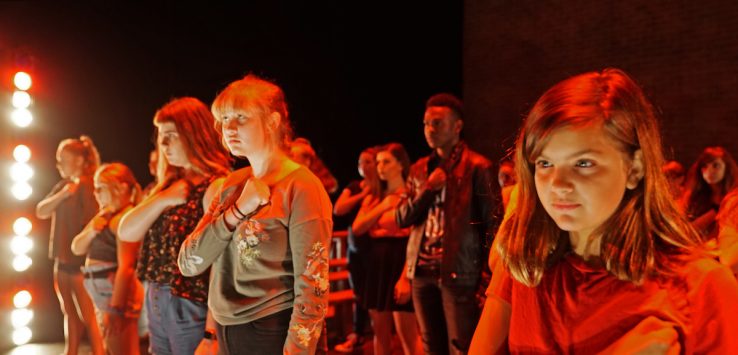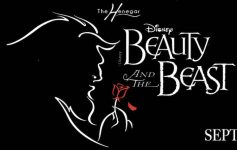CARRIE THE MUSICAL at the Henegar. Photo by Niko Stamos.
By KRISTIN SPRINGER
Guest Critic, BREVARD CULTURE
“Carrie the Musical” would never be everyone’s cup of tea (er, pail of pig blood, in this case). The Henegar’s recent Feller to Broadway production raised many questions about teenage relationships and violent revenge.
Written by Lawrence D. Cohen with lyrics by Dean Pitchford and music by Michael Gore, this unlikely musical is adapted from the Stephen King novel and 1976 movie. The 1988 Broadway production ran for only 16 previews and five performances. It focuses on an awkward teenage girl with telekinetic powers whose lonely life is dominated by an oppressively religious, fanatical mother. Carrie’s story is told via flashbacks from the perspective of Sue Snell, the sole survivor of the mayhem, beginning when Carrie is humiliated by her classmates in the gym locker-room. Her story culminates in a second humiliation at the senior prom, after which she unleashes chaos on everyone and everything in her path, and is gruesomely confronted by her mother back at home.
In the musical, timid Carrie White (Brooke Wolfington) is the victim of mental and psychological abuse by her mother Margaret (Luisa Garrett). Carrie’s P.E. teacher, Miss Gardner (Gaya Matican-Bock), is the first one to treat Carrie with kindness and forces the popular-mean girls to apologize for their bullying. This excites opposing reactions from girls who were once best friends, sympathetic Sue (Sarah Donovan) and bullying Chris (Sydney MacDonald). Another potential ally is Tommy Ross (Gabriel Waterman), Sue’s boyfriend who reluctantly agrees to take Carrie to the ill-fated prom.
Director Niko Stamos used edgy rock music and cellphone choreography and also created the scenic design. He used gym-like risers to form picnic tables and benches, had a brick-painted backdrop and a proscenium arch which caught projections and refracted light (courtesy of lighting designer Luke Atkison).
“Carrie the Musical” featured excellent singers in leading roles (coached by music director Spencer Crosswell) and hordes of enthusiastic dancer-singers (choreographed by Erica Bargas and Rachel Erickson and costumed by Jordyn Linkous).
This is a gruesome story of abuse versus acceptance. You will ask: Is the psychic ability to lock doors and set fire to your classmates just make believe? Or is it a metaphor for other forms of revengeful violence? Are the victims always innocent? If the viewer can maintain emotional distance, there is beauty in the song and dance; but for others “Carrie the Musical” may hit too close to home.











